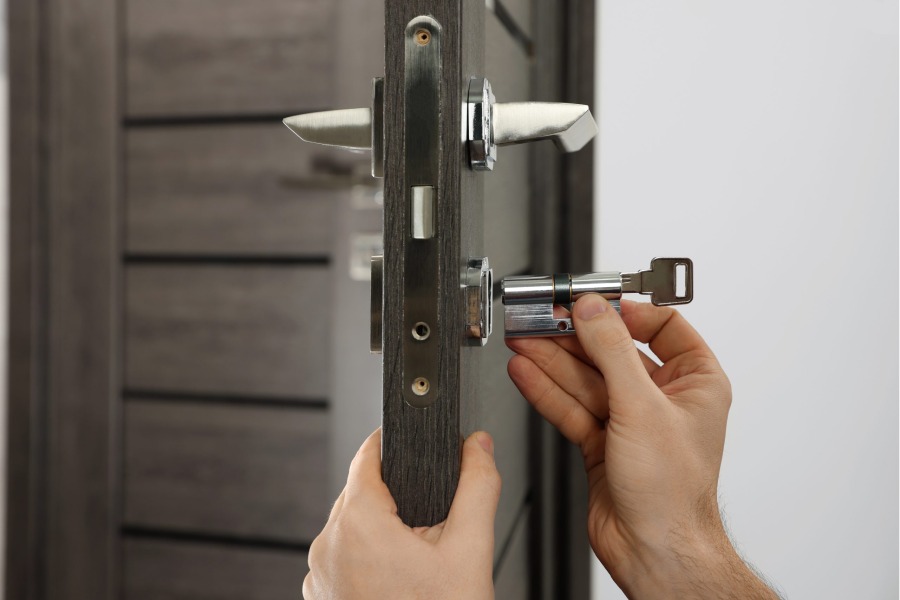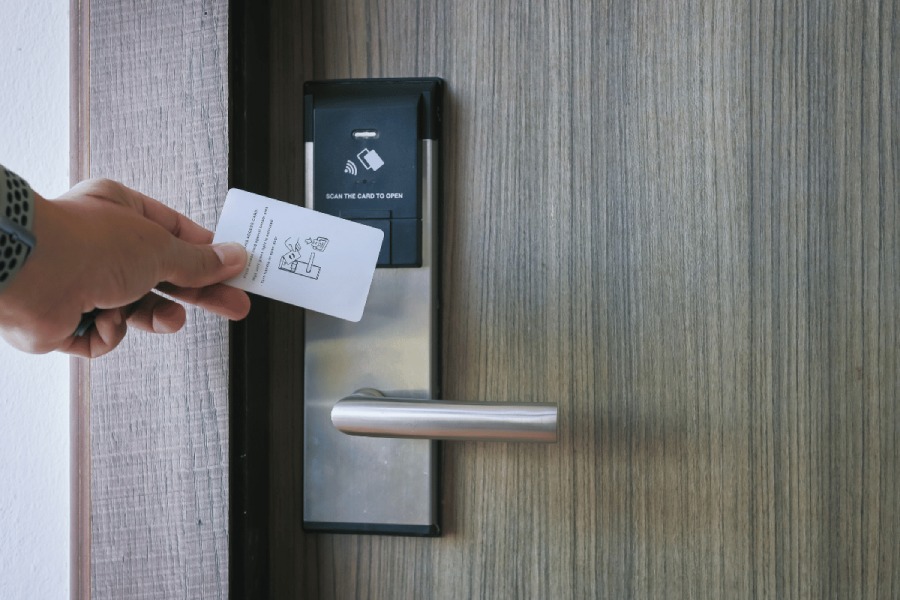Have you ever wondered how a locksmith manages to open a locked door without a key? The process is both an art and a science, involving a combination of skill, experience, and specialized tools. So, how does a locksmith open a door? Can locksmiths open any door?
Not all locksmiths can open doors. Only trained locksmiths who use specialized tools and techniques and have a deep understanding of lock mechanisms and security systems can execute the task ahead.

What is a Locksmith?
A locksmith is a skilled professional specializing in locks, keys, and security systems. They install, repair, and maintain various locking devices for residential, commercial, and automotive applications.
Locksmiths work with both mechanical and electronic locks, understanding their intricate mechanisms. Their role extends beyond just opening locked doors; they play a crucial part in maintaining security by assessing needs and recommending appropriate solutions.
Locksmiths must adhere to strict legal and ethical standards, often requiring licensing and bonding to ensure professionalism and customer protection.
Overview of Locksmith Services
Locksmith services cover a wide range of areas. Residential locksmiths handle home security needs, including lock installation, repair, and rekeying. Commercial locksmiths work with businesses, installing high-security systems and creating complex master key setups.
Automotive locksmiths specialize in vehicle-related issues, from creating new car keys to unlocking vehicles during lockouts. Emergency locksmith services provide 24/7 assistance for urgent situations like lockouts or break-in repairs.
Reasons You Might Need a Locksmith to Open a Door
Lost or Misplaced Keys
Losing keys is a common problem that can occur at home or while out. Keys may be misplaced within the house, falling between couch cushions, or getting mixed up with clutter. When outside, keys can be dropped or left behind at various locations. In these situations, a locksmith can provide new keys or rekey locks for security.
Keys Locked Inside
Getting locked out of your property can be extremely frustrating. Suppose you just came outside to grab the mail, and the door closes behind you with the keys inside. Once locked outside, the only solution to the problem would be to call a locksmith.
Broken Keys
Keys can break partially or completely inside a lock. This often happens with old or worn keys or when too much force is applied. Locksmiths have specialized tools to extract broken key pieces and can create new keys or repair locks as needed.
Malfunctioning Locks
Locks can malfunction due to regular wear and tear or weather-related issues. They may become stiff, difficult to turn, or fail internally. Extreme temperatures and moisture can also affect lock functionality. Locksmiths can diagnose these problems and offer appropriate repairs or replacements.
Emergency Lockout Situations
Late-night lockouts and emergencies requiring immediate access are critical situations. Emergency locksmiths offer 24/7 services to address these urgent needs, providing quick assistance regardless of the time or circumstances.

How Does a Locksmith Open a Door?
Locksmiths employ a variety of techniques to open doors, ranging from non-destructive methods to more invasive approaches when necessary. Their choice of method depends on the type of lock, the urgency of the situation, and legal and ethical considerations. So, how does a locksmith open a locked door?
Non-Destructive Entry Techniques
Lock-picking and bumping
Lock picking is often the first method a locksmith will attempt. This technique involves manipulating the lock’s internal components using specialized tools. The primary tools are a tension wrench, which applies rotational pressure to the lock cylinder and pick tools, which manipulate the lock pins.
The locksmith inserts the tension wrench into the keyway and applies slight pressure, then uses pick tools to lift each pin to the shear line. When all pins are correctly positioned, the lock cylinder can rotate, opening the door. Another non-destructive method is lock bumping. This technique uses a specially cut key called a bump key.
The locksmith inserts the bump key into the lock, applies slight rotational pressure, and then strikes the key with a tool. This causes the lock pins to jump momentarily, allowing the cylinder to turn. While effective on many pin tumbler locks, this method is less successful on high-security locks with anti-bump features.
Destructive Entry Techniques
When non-destructive methods fail, locksmiths may need to resort to more invasive techniques.
The most common technique is drilling the lock. The locksmith uses a power drill to destroy specific parts of the lock mechanism, disabling the locking components. This allows the lock to easily open but requires a lock replacement afterward.
In extreme emergencies, such as fire or medical situations, breaking the lock might be necessary. This can involve using tools like bolt cutters, sledgehammers, or hydraulic spreaders. This method is always a last resort due to the damage caused and the need for complete lock replacement.
Bypassing Techniques
Some situations allow for bypass methods. For simple spring latch locks, a credit card or similar thin, rigid object can sometimes be used to push back the latch. However, this method is ineffective against deadbolts and many modern doors have features to prevent this technique.
Specialized bypass tools exist for specific lock types. For example, an under-door tool can manipulate a thumb turn from the outside. These methods require skill and knowledge of lock designs to be effective.
Electronic and Smart Lock Techniques
As electronic and smart locks become more common, locksmiths have adapted their techniques. For electronic locks, methods might include exploiting software vulnerabilities or using specialized hardware to override lock circuits. Some advanced techniques involve decoding or cloning access cards.
Smart locks often require different approaches. Locksmiths may need to access the lock’s control panel to reset it to factory settings or reprogram it with new access codes. This method is particularly useful when access codes are lost or the smart lock malfunctions.
Legal and Ethical Considerations
Regardless of the method used, locksmiths must adhere to strict legal and ethical standards. Before opening any door, they must verify the client’s right to access the property.
This often involves checking identification and property documents, and in some cases, contacting property managers or landlords. Many jurisdictions require locksmiths to be licensed and bonded. They must keep records of their work for legal purposes and follow all local and national regulations.
Ethically, locksmiths play a crucial role in maintaining public safety and property security. They must balance customer service with security concerns and refuse any suspicious requests.

Conclusion
We hope this article has helped you understand the complexity and skill involved in locksmithing. From non-destructive methods like lock picking and bumping to more invasive techniques used in emergencies, locksmiths possess a diverse toolkit to address various situations.
The rise of electronic and smart locks has further expanded their expertise. Importantly, we’ve seen that the work of a locksmith goes beyond technical skills, involving crucial legal and ethical responsibilities.
Now that you know how does a locksmith open a door, you can better appreciate their expertise in helping people stuck without keys. Whether you’re facing a lockout or simply curious about the profession, remember that professional locksmiths are trained to provide safe, efficient, and lawful solutions.


